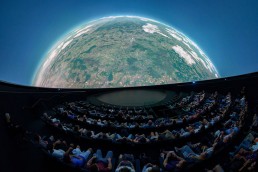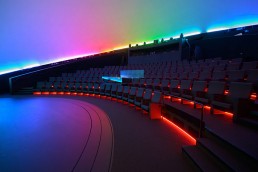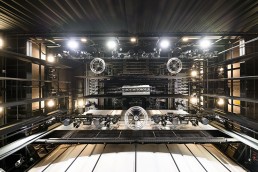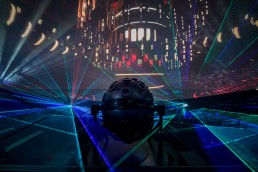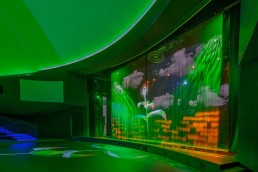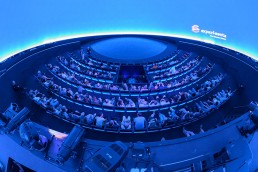This website uses cookies so that we can provide you with the best user experience possible. Cookie information is stored in your browser and performs functions such as recognising you when you return to our website and helping our team to understand which sections of the website you find most interesting and useful.
experimenta Science Dome
Projectexperimenta Science DomeLocationHeilbronn, GermanyManufacturers Meyer Sound, Barco, Epson, Allen & Heath, Chamsys, Lobo, Spitz, GradiorInstallerKraftwerk Living Technologies, AustriaSubmitted by Kraftwerk Living Technologies
What started with an idea for a relatively simple 4D theatre, morphed into a planetarium. In this process of developing an attraction, Kraftwerk LT was confronted with a challenging range of desired outcomes including using the space for training and as an education room, somewhere for special events and functions, a conventional and 3D cinema , experimental show space, concert/theatre location, planetarium, coupled with a limited footprint on which to deliver them, with limited space available due to the location on a river island. Consequently, Kraftwerk LT developed an idea was to combine a planetarium or a full dome system together with the stage scenario to enhance the multipurpose venue while still allowing it to be located in one room or one area.
Despite a wealth of experience in delivery of all the elements demanded – from domes in various shapes and sizes to theatre stages – KLT has never combined them all into one space. Nor has anyone else, as this concept for a hybrid venue is unique – not only in Germany but worldwide.
Next to the requirements of vastly differing applications of the venue itself, the demands on the technology were also incredibly high, with a very strong wish from the client to utilise only the latest and best equipment and solutions to create a highest quality as well as sustainable attraction.
Never before have such show scenarios been combined in one venue, with the audience involved in the transition sequence from stage to dome mode as well as part of the show. From digital cinema, musical performances, theater plays or lectures to 2D/3D fulldome, laser, experimental and planetarium – there is not much that cannot be done in the Science Dome with regards to entertaining and educating guests and visitors, and those hungry for science, knowledge and experience.
Being involved in the project from the very beginning and having developed the venue concept, selecting everything from carpet to audiovisual and then having successfully realised it, everyone involved could not be prouder of this project and how it turned out. The entire expansion is impressive and a wonderland for young and old alike to explore and venture; the Science Dome has become the very heart of the Science Center, allowing its guests to experience science in a unique, highly engaging and emotive way – all realised by smart, partly bold technologies.
With the very large project scope and highly sophisticated technology in use, several challenges were faced and successfully overcome. What was a crucial factor in a smooth implementation, was the involvement in the overall expansion project from the very beginning and the close cooperation with all involved parties – from the architect, the building construction crews and of course the end client.
The audio technology implemented consists essentially of a Stage Sound System, Effect Sound System, Digital Audio Matrix (Audio Distribution System), Digital mixing console, 3D Audio System and Room Acoustics.
The core of the audio technology in the Science Dome is a centralised, network-based audio system in combination with a digital audio mixing console. The audio network is designed redundantly to ensure fail-safe operation. The “Core” unit takes over the complete audio processing, the interfacing with input and output signals is realized via I/O frames. The sound system is designed for use as a cinema or planetarium, as a lecture room, as a concert hall and as an experimental field.
The Front of House sound system is designed as a classic L/C/R sound system in order to achieve optimum sound distribution over the entire stage width. In addition to the main loudspeakers, front fill loudspeakers are integrated in the front of the stage to cover the front areas of the audience. The low-end sound is provided by three subwoofers each on the left and right side of the stage. All loudspeakers are self-powered. (active)
The main supplier used for the state-of-the-art audio system for this dome installation was Meyer Sound.
The entire projection dome is illuminated by means of RGB LED light bars attached to the lower edge. In order to achieve a uniform illumination, powerful LEDs are used. By means of an Art-NET connection with the light mixer connected can also this lighting can be integrated into the running show.
LED strips (RGB) are installed on all stairs on the revolving stage as well as steps behind the fixed seating, which can be fully integrated into the show concepts as they can be controlled via DMX. Furthermore, the staircase light is connected to the emergency power supply and can be activated with the safety lighting if necessary.
LED strips (RGB) are installed on both loudspeaker towers to the left and right of the stage, which can be fully integrated into the show concepts as they can be controlled via DMX.
The installed system, with its six fibre-optic powered laser projectors is a relatively complex planetarium system. The system, which has been specially configured for the requirements of the Science Dome, is also ideally suited, e.g. in combination with conventional projection systems, for impressive 2D and 3D laser presentations with infotainment character. The system allows you an all-round projection on the dome as well as the generation of spatial beam effects into the audience, which are especially popular in the entertainment sector. This 360° fulldome laser projection called TriDome is a process that creates an Irradiation of the entire dome with laser graphics allowed. These are generated from four individual images fully automatically.
The stage spotlights of the Science Dome are positioned to perfectly illuminate the entire stage including the front stage. The individual stage spotlights are divided into the following areas: Front light (directing): The profile spotlights on the control room are used to provide sufficient front light for the stage and the front stage. The moving heads on the control room are used for stage effect lighting and dome effect lighting.
The audience is on the turntable, which was manufactured by Gradior. For this purpose, there are stepped, fixed rows of seats with assembled chairs. The rows of seats are 48cm higher than the one before. In the front area of the turntable, facing the scene area, an orchestra podium with two staircases is integrated. The orchestra podium is also driven scenically and part of the turntable. The turntable is rotated by 180 degrees as a major part of the show or also as special events.
The audience experiences the transitions as a highlight of the overall show being transported from one scenario into another. The starball, as in itself a visible, unique and exiting mechanical masterpiece, is located in the epicenter of the revolving stage. Invisible in its parking position it rises soundless, by a precise telescopic lift to appear in the centre of the audience. The opening in the floor is automatically opened and closed again by means of a horizontally movable cover. Thus, these movements of the cover and the lifting platform take place in scenic operation. As protection against falling into the lift shaft of the projector lift when the bottom cover is open, a four-glass guard rail is arranged around the lift shaft. The guardrail can be dismantled in order to additionally equip the cover with loose chairs when the lift shaft is closed.
Laser projectors act like a single fulldome 360° dome projector. In concrete terms, this means that laser effects can be placed freely on the dome without the user having to worry about the assignment to different projectors or the size of projection fields. In contrast to the star projector, however, real spatial journeys are also possible, so that you can fly through objects, for example. With a few simple steps and without external service provider, for example, a realistic flight through a star field or through a black hole can be programmed. The laser system thus complements the usual representation of conventional projection techniques with an incredibly spatial, dynamic component. The LACON-5 workstation calculates automatically and in real time the spherical distortion of the projection and provides a hardly visible translation from one projector to the other.

